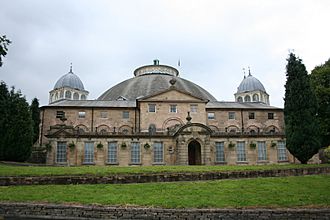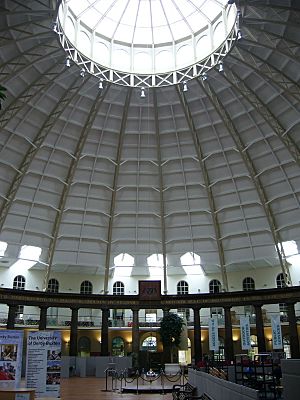Devonshire Dome facts for kids
Quick facts for kids The Devonshire Dome |
|
|---|---|
 |
|
| Former names | Devonshire Royal Hospital |
| General information | |
| Location | Buxton, Derbyshire |
| Coordinates | 53°15′36″N 1°55′00″W / 53.2600°N 1.9168°W |
| Construction started | 1780 |
| Completed | 1789 |
| Renovated | 1858, Henry Currey 1881, Robert Rippon Duke 2001-3, University of Derby |
| Renovation cost | £4.7 million (2001–03) |
| Client | William Cavendish, 5th Duke of Devonshire |
| Owner | University of Derby |
| Dimensions | |
| Diameter | 44.2 metres (145 ft) |
| Technical details | |
| Floor area | 1,534 square metres (16,510 sq ft) |
| Design and construction | |
| Architect | John Carr |
The Devonshire Dome is a famous building in Buxton, Derbyshire. It used to be called the Devonshire Royal Hospital. This very old building was built in the 1700s. It was first used as a stable for horses.
A famous architect named John Carr designed it. Later, another architect, Robert Rippon Duke, added a huge dome. This dome was once the largest in the world without any central supports! Today, the Devonshire Dome is part of the University of Derby. It is used as a college campus.
Contents
A Look Back in Time
A Home for Horses (1780-1850s)
The Devonshire Dome was built between 1780 and 1789. John Carr of York designed the original building. It was made for William Cavendish, 5th Duke of Devonshire.
The building was shaped like an octagon. It could hold up to 120 horses. It also housed servants for guests staying at the Crescent Hotel. This was all part of a plan to make Buxton a popular spa town.
From Stables to Hospital (1859-2000)
In 1859, the Buxton Bath Charity had an idea. They asked the Duke of Devonshire to let them use part of the building. It was not being used for many horses anymore. They wanted to turn it into a hospital for sick people. These people came from places like Lancashire and Yorkshire.
Henry Currey, an architect for the Duke, helped. He changed two-thirds of the building into a hospital.
In 1881, the charity asked the Duke for the whole building. They promised to build new stables somewhere else. A local architect, Robert Rippon Duke, was chosen. He designed a hospital with 300 beds. This new hospital was meant to be as good as others in Bath and Harrogate.
The building's famous dome was part of Rippon Duke's design. It was the world's largest unsupported dome at the time. It measured 44.2 metres (145 ft) across. This was bigger than the domes of the Pantheon and St Peter's Basilica in Rome. It was also larger than St Paul's Cathedral.
The dome's record was later broken in 1902. Today, even bigger domes exist, like the Georgia Dome. But the Devonshire Dome is still the largest unsupported dome in the UK. Its floor area is 1,534 square metres (16,510 sq ft).
More changes were made to the hospital. A clock tower was finished in 1882. New wards for surgery were added in 1897. Spa baths were built in 1913. A dining room and kitchens were added in 1921. The building became known as the Devonshire Royal Hospital in 1934. It was the last of England's eight special water-treatment hospitals to close. This happened in the year 2000.
A Campus and Event Space (2001-Present)
On January 31, 2001, the University of Derby bought the Devonshire Dome. They also bought the buildings around it. The University received money to help restore the building.
The Dome was renovated and reopened in 2003. The main building and its old villas are now part of the University of Derby. The Devonshire Dome is used as a campus for the University of Derby and Buxton & Leek College. It is also a place for events and visitors.
As a university campus, it has hosted many courses. These include Outdoor Leadership, Events Management, and Hospitality Management. In 2019, the University announced some changes. From 2022, some courses will move to the main campus in Derby. However, the Dome will continue to be an education campus for Buxton & Leek College.
The Dome is also a popular place for events. It is often used for large weddings. It has even hosted celebrity weddings. The building is open to the public. You can find cafés, a restaurant, and study spaces inside. Sometimes, visitors can watch a special pendulum swing.
In 2015, the Dome hosted a boxing match. Jack Massey won a boxing title there.
See also
 In Spanish: Hospital real de Devonshire para niños
In Spanish: Hospital real de Devonshire para niños


